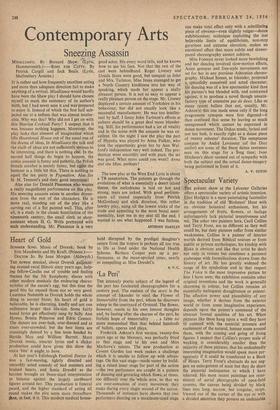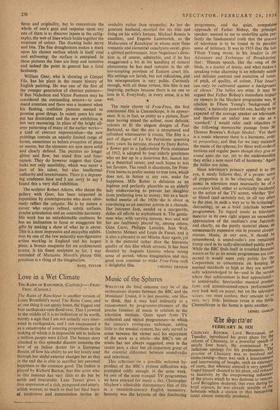Spectacular Variety
Tnn present show at the Leicester Galleries offers a spectacular variety of artistic intention. Eliot Hodgkin is a most painstaking facsimilist in the tradition of old 'Birdsnest' Hunt with an obvious botanical enthusiasm, but his arrangements of fruits, flowers, or leafage unfortunately lack pictorial inventiveness and wit. The other two painters here, Cecil Collins and Terry Frost, are as different as they well could be, but their pictures suffer from similar weaknesses. Collins is a painter of interior worlds derived from Biblical sources or from public or private mythologies; his kinship with Blake is obvious and like that artist he deals . not only in visions but combines a personal arabesque with formalisations drawn from the history of art. He has greatly widened the range of his symbolism and in that respect The Voice is the most impressive picture by him I have seen; the exhibition contains other original inventions and the work is generally charming in colour, but Collins remains an essentially ineloquent draughtsman or painter. The affective power and plausibility of any image, whether it derives from the exterior world or from some imaginative experience, depends upon the painter's command of the abstract formal qualities of his art. When pictures like these hang upon a wall they have to contend with the material pressure and excitement of the natural, human scene around them, with the coming and going of living figures. I suspect that Collins's proper scale of working is considerably smaller than the majority of these pictures, that his undoubtedly interesting imagination would speak more per- suasively if it could be transferred to a Book of Hours. Terry Frost's abstracts do not sug- gest an enlargement of scale but they do share the pictorial ineloquence to which I have referred. His most recent paintings are remi- niscent of aerial photographs of open-field systems, the canvas being divided by black lines into long, narrow, but irregular, strips. Viewed out of the corner of the eye or with a divided attention they possess an undeniable force and originality, but to concentrate the whole of one's gaze and response upon any one of them is to discover lapses in the callig- raphy, the web of lines which holds together the structure of colour. The drawing lacks nerve and bite. The fine draughtsman makes a mark upon his chosen surface which is itself vital and enlivening; the surface is energised. In these pictures the lines are limp and tentative and indeed the paint in general has a fatal hesitancy.
William Gear, who is showing at Gimpel Fits, has his place in the recent history of English painting. He was one of the first of
the younger generation of abstract painters— if Ben Nicholson and Victor Pasmore may be considered the outstanding seniors—to com- mand attention and there was a moment when his flashing, confident pictures seemed to promise great things. In recent years his out- put has diminished and the new exhibition is not very reassuring. In place of the bright all- over patterning of many of the earlier works- - a kind of abstract impressionism—the new paintings contain an equally limited range of forms, sometimes as before evocative of place or season, but the elements arc now more solid and clearly defined. The pictures no longer glitter and flow, but stand firm and four- square. They do however suggest that Gear lacks not only sensibility, which was never a part of his talent, but also intellectual authority and inventiveness. There is a depress- ing crudeness here and I am sorry to say I found this a very dull exhibition.
The sculptor Robert Adams. who shares the gallery with Gear, has 'been surpassed in reputation by contemporaries who more obvi- ously reflect the zeitgeist. He is by nature a carver who enjoys refined, subtle surfaces, precise articulation and an ostensible harmony. His work has an unfashionable coolness; he has no inclination to force or exaggerate his gifts by making a show of what he is about. This is a most impressive and enjoyable exhibi- tion by one of the few naturally non-figurative artists working in England and his largest piece, a bronze maquette for an architectural screen, is his finest sculpture so far. I was reminded of Marianne Moore's phrase that precision is a thing of the imagination.
BASIL TAYLOR



































 Previous page
Previous page